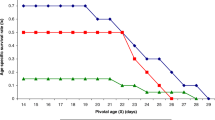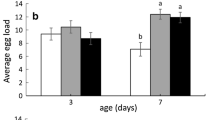Abstract
The braconid Cotesia plutellae(Kurdjumov) (Hymenoptera: Braconidae) is amajor solitary, larval endoparasitoid of thediamondback moth, Plutella xylostella(L.) (Lepidoptera: Plutellidae). Parasitism oflarvae of different host instars and fourdevelopmental ages of the 4th instar ofthe pest was examined. The effects of hostinstar at initial parasitization on thedevelopment, survival, size and fecundity ofthe parasitoid were determined in thelaboratory at 25 °C. The effects ofparasitism on host development and foodconsumption were investigated at 28 °C.Cotesia plutellae could parasitize larvaeof all four instars of P. xylostella, butpreferred 2nd and 3rd instars. In achoice test, the relative parasitism indicesfor 2nd, 3rd and 4th instarswere 0.37, 0.39 and 0.24, respectively.Parasitism decreased sharply with increasinghost age in the 4th instar and approachedzero in host larvae that had gone beyond 37%of 4th stadium. The development time andthe final adult size of the parasitoid variedwith the host instar at initial parasitization.Parasitoids with initial parasitism in the4th instar hosts had the shortestdevelopment time, followed by those in the3rd instar, and then by those in the2nd instar. Parasitoids startingparasitism in 2nd instar hosts weresmaller in body size than those starting in the3rd or 4th instar. However, resultantfemales starting parasitism in 3rd instarhosts had the highest fecundity. Parasitizedlarvae exhibited longer development time andincreased food consumption compared withunparasitized ones. This study presents thefirst record that a solitary parasitoidregulates host behavior leading to an increasein food consumption by the host.
Similar content being viewed by others
References
Arida, G.S., B.M. Shepard and L.P. Almazan, 1989. Effect of parasitization on food consumption of rice leaffolder (LF) Marasmia patnalis. International Rice Research Newsletter 14:37.
Beckage, N.E., 1990a. Induction of host endocrine and hemolymph protein alterations in tobacco hornworm larvae parasitized by Cotesia congregata. Adv. Invertebr. Reprod. 5: 149–155.
Beckage, N.E., 1990b. Parasitic effects on host development. In: R. Baker and P.R. Dunn (eds), New Directions in Biological Control: Alternatives for Suppressing Agricultural Pests and Diseases. Liss, New York. pp. 497–515.
Bentz, J.A. and P. Barbosa, 1990. Effects of dietary nicotine (0.1%) and parasitism by Cotesia congregata on the growth and food consumption and utilization of the tobacco hornworm, Manduca sexta. Entomol. Exp. Appl. 57: 1–8.
Brodeur, J., J.B.F. Greervliet and L.E.M. Vet, 1996. The role of host species, age and defensive behavior on ovipositional decisions in a solitary specialist and gregarious generalist parasitoid (Cotesia species). Entomol. Exp. Appl. 81: 125–132.
Coleman, R.A.,A.M. Barker and M. Fenner, 1999. Parasitism of the herbivore Pieris brassicae L. (Lep., Pieridae) by Cotesia glomerata L. (Hym., Braconidae) does not benefit the host plant by reduction of herbivory. J. Appl. Ent. 123: 171–177.
Cook, M.J.M., 1978. The assessment of preference. J. Anim. Ecol. 47: 805–816.
Doetzer, A.K. and L.A. Foerster, 1998. Effect of parasitism by Glyptapanteles muesebecki (Blanchard) on food consumption and utilization by Pseudaletia sequax Franclemont. Anais da Sociedade Entomologica do Brasil. 27: 255–264.
Dover, B.A., D.H. Davies and S.B. Vinson, 1988. Dose-dependent influence of Campoletis sonorensis polydnavirus on the development and ecdysteroid titers of last-instar Heliothis virescens larvae. Arch. Insect Biochem. Physiol. 8: 113–126.
Gobbi, N., J. Chaud-Netto, J.A.F. Diniz-Filho, S.M.T. Tornisielo, L.C. de Almeida, S.L. Nazareth and L.C. De-Almeida, 1993. Study of the relationship between Cotesia flavipes and Diatraea saccharalis. I. Effect of parasitism on the food consumption of 4th-instar larvae. Naturalia Sao Paulo. 18: 201–206.
Harvey, J.A., M.A. Jervis, R. Gols, N.Q. Jiang and L.E.M. Vet, 1999. Development of the parasitoid, Cotesia rubecula (Hymenoptera: Braconidae) in Pieris rapae and Pieris brassicae (Lepidoptera: Pieridae): evidence for host regulation. J. Insect Physiol. 45: 173–182.
Harvey, J.A., K. Kadash and M.R. Strand, 2000. Differences in larval feeding behavior correlate with altered developmental strategies in two parasitic wasps: implications for the size-fitness hypothesis. Oikos 88: 621–629.
Hayakawa, Y., 1990. Juvenile hormone esterase activity repressive factor in the plasma of parasitized insect larvae. J. Biol. Chem. 265: 10813–10816.
Hill, M.G., 1988. Analysis of the biological control of Mythimna separata (Lepidoptera: Noctuidae) by Apanteles ruficrus (Braconidae: Hymenoptera) in New Zealand. J. Appl. Ecol. 25: 197–208.
Kfir, R., 1997. Parasitoids of Plutella xylostella (Lep.: Plutellidae) in South Africa: an annotated list. Entomophaga 42: 517–523.
Kumar, P. and C.R. Ballal, 1992. The effect of parasitism by Hyposoter didymator (Hym.: Ichneumonidae) on food consumption and utilization by Spodoptera litura (Lep.: Noctuidae). Entomophaga 37: 197–203.
Lawrence, P.O. and B. Lanzrein, 1993. Hormonal interactions between insect endoparasites and their host insects. In: N.E. Beckage, S.N. Thompson and B.A. Federici (eds), Parasites and Pathogens of Insects. Vol. 1. Academic Press, San Diego, CA. pp. 59–86.
Liu, S.S., X.G. Wang, S.J. Guo, J.H. He and Z.H. Shi, 2000. Seasonal abundance of the parasitoid complex associated with the diamondback moth, Plutella xylostella (Lepidoptera: Plutellidae) in Hangzhou, China. Bull. Entomol. Res. 90: 221–231.
Mackauer, M. and R. Sequeira, 1993. Patterns of development in insect parasites. In: N.E. Beckage, S.N. Thompson and B.A. Federici (eds), Parasites and Pathogens of Insects. Vol. 1. Academic press, San Diego, CA. pp. 1–12.
Mushtaque, M. and A.I. Mohyuddin, 1987. Apanteles plutellae Kurdj. (Braconidae: Hymenoptera), an effective parasite of the diamondback moth, in Pakistan. Pakistan J. Zool. 19: 341–348.
Noda, T., S. Miyai and S. Yamada, 1996. Larval and pupal parasitoids of diamondback moth, Plutella xylostella (L.) in cabbage fields in Moriok, Japan. Japanese J. Appl. Entomol. Zool. 40: 164–167.
Ohnuma, Y. and Y. Kainoh, 1992. Effect of parasitism by Ascogaster reticulates (Hym.: Braconidae) on growth of the host, Adoxophyes sp. (Lep.: Tortricidae). Entomophaga 37: 327–332.
Powell, J.E., 1989. Food consumption by tobacco budworm (Lepidoptera: Noctuidae) larvae reduced after parasitization by Microplitis demolitor or M. croceipes (Hymenoptera: Braconidae). J. Econ. Entomol. 82: 408–411.
Shi, Z.H. and S.S. Liu, 1999. Influence of temperature on the development, survival and reproduction of Cotesia plutellae, a larval parasite of Plutella xylostella. Acta Phytophylacica Sinica 26: 142–146 (in Chinese with English summary).
Talekar, N.S. and J.C. Yang, 1991. Characteristics of parasitism of diamondback moth by two larval parasites. Entomophaga 36: 95–104.
Tanaka, T. and S.B. Vinson, 1991. Depression of prothoracic gland activity of Heliothis virescens by venom and calyx fluids from the parasitoid, Cardiochiles nigriceps. J. Insect Physiol. 37: 139–144.
Velasco, L.R.I., 1982. The life history of Apanteles plutellae Kurdj. (Braconidae), a parasitoid of the diamondback moth. The Philip. Entomol. 5: 385–399.
Vinson, S.B. and G.F. Iwantsch, 1980. Host regulation by insect parasitoids. Quarterly Review of Biology 55: 143–165.
Wani, M., K. Iwabuchi, N. Agui and J. Mitsuhashi, 1997. Endocrine alternation and precocious premetamorphic behaviors in the greater wax moth larvae, Galleria mellonella, parasitized by an endoparasitoid, Apanteles galleriae. Arch. Insect Biochem. Physiol. 34: 257–273.
Wang, X.G., S.S. Liu, S.J. Guo and W.C. Lin, 1999. Effects of host stages and temperature on population parameters of Oomyzus sokolowskii, a larval-pupal parasitoid of Plutella xylostella. BioControl 44: 391–402.
Waterhouse, D.F. and K.R. Norris, 1987. Biological Control — Pacific Prospects. Inkata Press, Melbourne.
Yang, J.C., Y.I. Chu and N.S. Talekar, 1994. Studies on the characteristics of parasitism of Plutella xylostella (Lep.: Plutellidae) by a larval parasite Diadegma semiclausum (Hym.: Ichneumonidae). Entomophaga 39: 397–406.
Author information
Authors and Affiliations
Corresponding author
Rights and permissions
About this article
Cite this article
Shi, Zh., Liu, Ss. & Li, Yx. Cotesia plutellae parasitizing Plutella xylostella: Host-age dependent parasitism and its effect on host development and food consumption. BioControl 47, 499–511 (2002). https://doi.org/10.1023/A:1016577406820
Issue Date:
DOI: https://doi.org/10.1023/A:1016577406820




